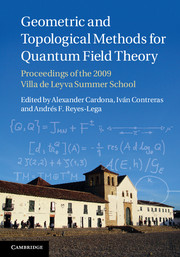 Geometric and Topological Methods for Quantum Field Theory
Geometric and Topological Methods for Quantum Field Theory Book contents
- Frontmatter
- Contents
- List of contributors
- Introduction
- 1 A brief introduction to Dirac manifolds
- 2 Differential geometry of holomorphic vector bundles on a curve
- 3 Paths towards an extension of Chern–Weil calculus to a class of infinite dimensional vector bundles
- 4 Introduction to Feynman integrals
- 5 Iterated integrals in quantum field theory
- 6 Geometric issues in quantum field theory and string theory
- 7 Geometric aspects of the Standard Model and the mysteries of matter
- 8 Absence of singular continuous spectrum for some geometric Laplacians
- 9 Models for formal groupoids
- 10 Elliptic PDEs and smoothness of weakly Einstein metrics of Hölder regularity
- 11 Regularized traces and the index formula for manifolds with boundary
- Index
- References
1 - A brief introduction to Dirac manifolds
Published online by Cambridge University Press: 05 May 2013
- Frontmatter
- Contents
- List of contributors
- Introduction
- 1 A brief introduction to Dirac manifolds
- 2 Differential geometry of holomorphic vector bundles on a curve
- 3 Paths towards an extension of Chern–Weil calculus to a class of infinite dimensional vector bundles
- 4 Introduction to Feynman integrals
- 5 Iterated integrals in quantum field theory
- 6 Geometric issues in quantum field theory and string theory
- 7 Geometric aspects of the Standard Model and the mysteries of matter
- 8 Absence of singular continuous spectrum for some geometric Laplacians
- 9 Models for formal groupoids
- 10 Elliptic PDEs and smoothness of weakly Einstein metrics of Hölder regularity
- 11 Regularized traces and the index formula for manifolds with boundary
- Index
- References
Summary
Abstract
These lecture notes are based on a series of lectures given at the school on “Geometric and Topological Methods for Quantum Field Theory”, in Villa de Leyva, Colombia. We present a basic introduction to Dirac manifolds, recalling the original context in which they were defined, their main features, and briefly mentioning more recent developments.
Introduction
Phase spaces of classical mechanical systems are commonly modeled by symplectic manifolds. It often happens that the dynamics governing the system's evolution are constrained to particular submanifolds of the phase space, e.g. level sets of conserved quantities (typically associated with symmetries of the system, such as momentum maps), or submanifolds resulting from constraints in the possible configurations of the system, etc. Any submanifold C of a symplectic manifold M inherits a presymplectic form (i.e. a closed 2-form, possibly degenerate), given by the pullback of the ambient symplectic form to C. It may be desirable to treat C in its own right, which makes presymplectic geometry the natural arena for the study of constrained systems; see e.g. [23, 25].
In many situations, however, phase spaces are modeled by more general objects: Poisson manifolds (see e.g. [35]). A Poisson structure on a manifold M is a bivector field π ϵ Γ(Λ2TM) such that the skew-symmetric bracket {f, g} ≔ π(df, dg) on C∞(M) satisfies the Jacobi identity. Just as for symplectic phase spaces, there are natural examples of systems on Poisson phase spaces which are constrained to submanifolds. The present notes address the following motivating questions: what kind of geometric structure is inherited by a submanifold C of a Poisson manifold M?
- Type
- Chapter
- Information
- Geometric and Topological Methods for Quantum Field TheoryProceedings of the 2009 Villa de Leyva Summer School, pp. 4 - 38Publisher: Cambridge University PressPrint publication year: 2013
References
- 17
- Cited by


